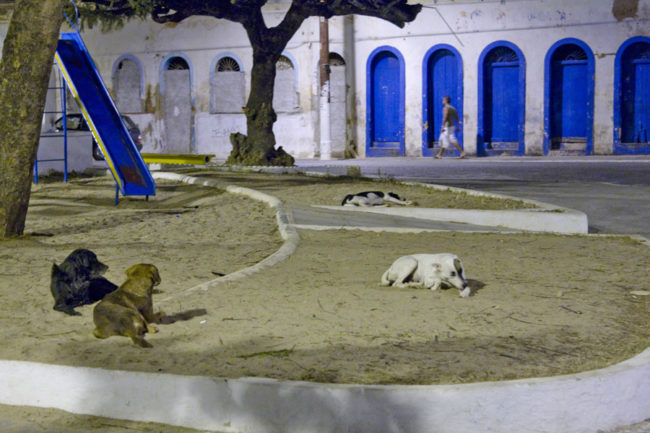Second day in Salvador–part 5
 The Mestre across the courtyard from
The Mestre across the courtyard from
Mestre Boca Rica
We said goodbye to Mestre Boca Rica, and proceeded to peek in a couple of the other classrooms that ringed the courtyard. There was nobody in any of the ones on Boca Rica’s side, so we crossed the massive courtyard, stopping to marvel at a big concrete cylinder in the middle.
Once on the other side, we encountered the school of this guy. I never got his name, but there were two or three people fluttering around him like he was somebody important.
I began to wonder if he and Mestre Boca Rica would duke it out with dueling berimbaus across the courtyard, and then go all capoeira on each other in the middle.
At any rate, he posed for pictures without complaint. On the wall just as you walked in was a portrait of St. George and the dragon. It was the second time I had seen it down there. It is obviously one of their important motifs.
At this age, you never pass up a bathroom, so after stopping at the sanitario, we headed toward the gate. On the way out, we decided to investigate the concrete cylinder, and found that it was a wall around an old cistern. The wall looked new, and I wondered what blocked it in the past. What a laugh that would be to see some guy capoeira himself right into this hole.
 Once outside, we discovered the beautiful view off the mountain.
Once outside, we discovered the beautiful view off the mountain.
 At a right angle to the fort on the courtyard was an old, beautiful colonial church, Santo Antonio Alem do Carmo. It is obviously still in use, because there was brand new playground equipment in front of it, and there were even a few food vendors already set up around the perimeter of the place square.
At a right angle to the fort on the courtyard was an old, beautiful colonial church, Santo Antonio Alem do Carmo. It is obviously still in use, because there was brand new playground equipment in front of it, and there were even a few food vendors already set up around the perimeter of the place square.


Of course one of the things I liked the best about the whole view was the gang of lazy dogs just hanging around and reminding me of Zoey and Spike. They were funny. They’d lay down for a while. Get up, walk around a little bit and then lie down again. They were oblivious to everything, and I would have loved to have met them, but decided to forgo it.


 It was time to wend. We were in a very old section of Salvador, Santo Antonio Alem do Carmo, (duh), one that had recently become renovated and brought to new life by Europeans. Carol piloted that SUV like a champion over cobblestone streets that were as old as Dom Pedro himself. The streets were steep, curvy, and lined cheek to jowl with colonial storefronts, apartments and houses.
It was time to wend. We were in a very old section of Salvador, Santo Antonio Alem do Carmo, (duh), one that had recently become renovated and brought to new life by Europeans. Carol piloted that SUV like a champion over cobblestone streets that were as old as Dom Pedro himself. The streets were steep, curvy, and lined cheek to jowl with colonial storefronts, apartments and houses.
I managed to take a couple of shots from the car.
We parked in an impossible place for any car, much less a big one, and gingerly alighted from the SUV onto the totally uneven cobbles. Carol had advised that I be mindful of my camera, so I had it in duffel position #1, with drawstring wrapped.
Jean and I were being particularly vigilant of the uneven street, and I was constantly in high mental gear, lest some toughs rush by and try to grab my camera.

 We passed by edifice after edifice, each scrolled with beautiful colonial details. It looked like something from St. Tropez as much as it did Brazil. Our destination at the top of a couple of hills was an old 16th century convent that was now re-purposed as a 6 star Hotel, the Convento do Carmo.
We passed by edifice after edifice, each scrolled with beautiful colonial details. It looked like something from St. Tropez as much as it did Brazil. Our destination at the top of a couple of hills was an old 16th century convent that was now re-purposed as a 6 star Hotel, the Convento do Carmo.
Carol’s dazzling Portuguese garnered us access to limited areas of the hotel ONLY, but it got us in, nevertheless. I only took a couple of pictures, mainly of this urn and whoever would stand in front of it. But only if they would answer the question, “What’s a Brazilian urn?” Jean did, but the picture was too blurry. But guess whose wasn’t! (Many thanks to my pal Pumpie for pointing out that I originally had written “who’s wasn’t”. I should be KILLED!)
